Tariffs and Shipping Delays
All items that are in stock, listed to the right, are in the USA and are not subject to tariffs or shipping delays. If you want premium trout rods, they're here now.
Tenkara - Finesse Fly Fishing
Finesse Fly Fishing? Most would argue that fly fishing is finesse fishing to begin with. Most trout flies are smaller than the smallest baits or lures. The presentation you get with a fly rod is almost as delicate as you can achieve.
I say almost because there is a fishing style that is even more subtle and even more delicate than fly fishing.
If you are interested in finesse fly fishing let me tell you about tenkara. I tried to tell the Ultralight Fly Fishing folks about it, but they weren't interested. That is unfortunate, because tenkara is way more "ultra" than what they were using. It still uses the weight of the line to cast the fly, but the weight of the line is a tiny fraction of the weight of even the lightest fly line. Truly, it is much closer to the weight of just the leader, let alone the fly line.
Even with a line that light, the casting is precise. The rods are specifically designed to cast the almost weightless line. Because the line is extremely light the drifts are more natural and the catches are more frequent. Most people who try tenkara report that they catch more fish. That is a common theme in any area of finess fishing, and finesse fly fishing is no different.
Although the exact origin of the word "tenkara" is not known, the literal translation is "from the sky" and it accurately describes the way an unweighted fly falls to the water's surface without so much as a ripple. Unlike in western fly fishing, where a floating line can land with a splash or cast a shadow over a wary trout, tenkara masters cast so that their line never touches the water.
That may sound either mystical or downright impossible, but it is not only possible, it is achievable by any angler who puts in the time to practice and who chooses his or her equipment wisely.
The key to keeping your line off the water is to choose a long rod (as long as you can get away with) and a light line (as light as you can get a way with). The combination of the long rod and light line, plus keeping the rod tip high is half the battle. The other half is ending your forward cast with the rod tip high, so that the fly lands first.
I cannot overemphasize the importance of your fly landing first. When you cast upstream, raise your rod tip as the fly drifts back down. That keeps the brightly colored line off the water
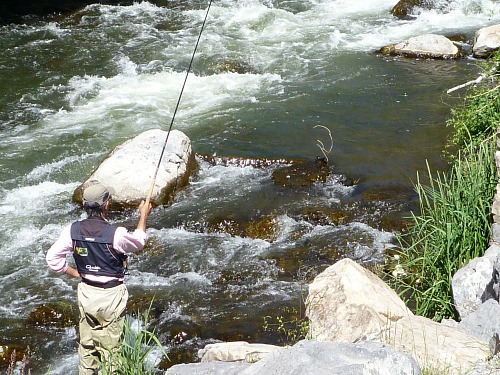 Masami Sakakibara keeping his rod tip high.
Masami Sakakibara keeping his rod tip high.The benefit of a fly-first cast and the ability to keep your line off the water to minimize drag is not just to avoid lining fish, though. You can now cast to, and fish, targets that are impossible to fish effectively with a fly line that gets caught in the current as soon as it lands - pulling your fly out of the target zone.
When you cast downstream (and some tenkara techniques utilize a downstream cast) the pressure of the water on the fly keeps the light line off the water. In western fly fishing, that would be called "skating" the fly, but in western fly fishing the line is on the water, scaring fish.
There are several types of tenkara line, and each has its fans. For finesse fly fishing, though, the best tenkara line to use is level hi-vis fluorocarbon line. It is high density so it is easy to cast. It is hi-vis so it is easy to see. Hesitations or twitches in the line may be your only indication of a subtle take. Other line types, whether furled or floating, are heavier and thus harder to keep off the water's surface. To achieve finesse fly fishing, you want your line off the surface (except for when you consciously use stream features to pull your unweighted fly deeper, in which case your line must be in the water).
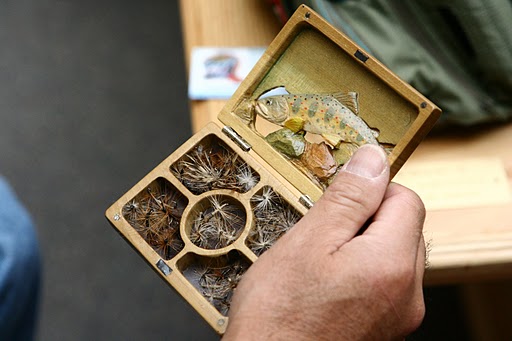 Dr. Ishigaki's fly box.
Dr. Ishigaki's fly box.There may be as many tenkara fly patterns as there are tenkara anglers. The flies are simple in design and simple to tie. They do not seek to match specific insects, and are thus impressionistic rather than realistic. Most tenkara anglers in Japan use only a few patterns - perhaps loosely based on a few recognizable styles, but generally unique to the angler. Nearly all are wet flies. Few have names other than just "kebari," which is the generic term describing any fly pattern of Japanese origin.
In the west we have named several Japanese tenkara fly patterns, for example the Takayama Sakasa Kebari - which would more accurately be called "any one of several different Japanese tenkara flies (kebari) utilizing the reverse (sakasa) hackle style that were used in the region around Takayama."
The key to the outstanding effectiveness of tenkara, and why it truly is finesse fly fishing, is not the fly, though. It is the way the fly is presented. That presentation often involves manipulating the fly. It is not an exaggeration to say that fly manipulation is central to tenkara. Anglers will
start with a natural, drag free drift but if that doesn't yield a
strike, they will try any of several subtly different fly manipulation
techniques (which could be loosely described as pulsing the fly). With the shorter rod and the heavier line stuck in the surface tension, western fly fishing gear just cannot perform the same degree of fly manipulation.
Tenkara is Finesse Fly Fishing
There are several aspects, unique to tenkara, that truly make it finesse fly fishing. The rod is long, the line is light and the line is tied to the rod tip. That means you are casting the same length of line with every cast, so you can become extremely accurate. With the line held off the water's surface, you have almost no drag. The fly doesn't move unless you want it to.
If a drag-free drift doesn't draw strikes, then you want the fly to move, to entice the fish to strike. The long tenkara rod and light tenkara line, held off the water's surface, allow any number of manipulation techniques, ranging from a gentle rhythmic pulse upstream or across the current, to a pulse interspersed with a drift (like a series of Liesenring Lifts), to skating the fly to using a breeze to make the fly bounce on the surface. What you can do with your fly is limited only by your imagination (and your skill level).
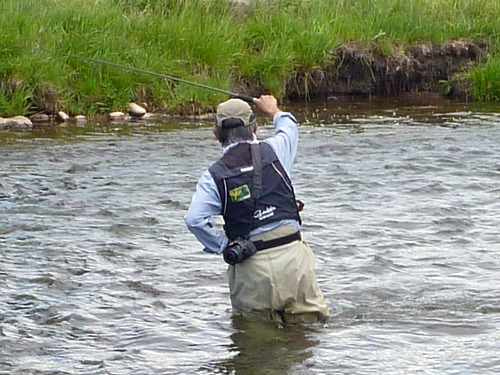 Masami Sakakibara fishing a current seam.
Masami Sakakibara fishing a current seam.In Japan, tenkara is specifically and solely a method for fishing mountain streams. A Japanese tenkara master does not just use a rod and line and fly, he also uses the water. The current and eddies and seams and plunge pools are all utilized for subtle manipulation techniques, and they are just as much a part of tenkara as the rod is.
For example, a plunge pool can be used to sink a fly towards the pool bottom (the same fly that you previously fished on the surface, wiggling like a stuck insect with your rod held high and your forefinger tapping the grip to send vibrations through the rod and down the line). An eddy or back current can be used to hold a fly motionless because your line, held above the water's surface, doesn't get swept downstream.
With respect to tenkara, you will often read "rod, line, fly." There are four elements, though: Rod, Line, Fly and Water. The master uses them all. To understand why each is important and how they are all interrelated is to understand why tenkara is finesse fly fishing.
I found it very interesting that one of the Japanese anglers who posts very nice videos on Bait Finesse Fishing for trout said in one of his videos that he wished he could get the same simple, direct connection with the fish on his baitcaster that is possible with a tenkara rod.
With tenkara, there is no need to mess with reel settings and you don't feel that you spend your whole day reeling. It is just pinpoint cast, a short drift and another pinpoint cast. Your casts are much shorter, but even that gives you a closer connection to the fish. Granted, he is a lure fisherman, not a fly fisherman, but it is still a valid point whether lure fishing or fly fishing.
The fly manipulation that is a key part of tenkara fishing is also so much more delicate than the twitching of a lure or even the stripping of a streamer. The Japanese term for it, when translated by Google, comes out as the "invitation." It really is almost as if you are asking the fish to come out and play for a while.
One final point, the Ultralight Fly Fishing folks finally tried tenkara and were won over. It really is the ultimate in ultralight, and it is indeed finesse fly fishing.
Keiryu - Finesse Bait Fishing
Finesse Bait Fishing is the opposite end of the spectrum from a night crawler on a size 6 hook, a big split shot, a forked stick and a long wait. It is a small bait on a light line with as little added weight as possible. You might not absolutely need to wade, but for most streams you'll catch more fish if you do.
Please note: Finesse Bait Fishing is NOT the same as Bait Finesse System.
Finesse Bait Fishing is delicate and subtle fishing with bait - REAL
bait, as in worms, salmon eggs, etc, not "baits" as in jerkbaits or
crankbaits. Bait Finesse System (BFS) is a system consisting of rods,
reels, lines, lures and techniques for ultralight fishing with bait
casting rods.
Just
as the Japanese fly fishing technique called tenkara is much more
finesse than than western fly fishing, their bait fishing technique,
called keiryu fishing, is more finesse than the way so many Americans
fish.
The
Japanese word "keiryu" means mountain stream. Although keiryu fishing
could include any type of fishing when done in a mountain stream, the
general sense of keiryu fishing is that style of fishing done with a
very long rod, a very light line tied to the rod tip, "markers" on the
line to signal strikes, a split shot for weight and a natural bait.
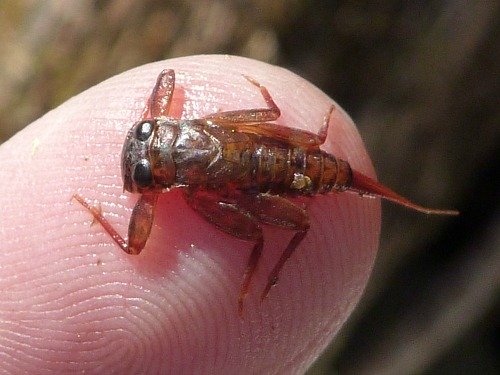 A nymph taken from the stream bottom is a perfect bait (where legal).
A nymph taken from the stream bottom is a perfect bait (where legal).For keiryu anglers, the goal is to achieve a natural drift with a natural bait. Their baits are small - no night crawlers (or even night crawlers pinched in half). The most common baits are caddis larvae or mayfly nymphs collected from the stream they are fishing, salmon eggs, wax worms (which the Japanese call bee moth larvae) and red wigglers. To get a natural drift, they use only "just enough" weight to get the bait down to the fish.
Long Rod
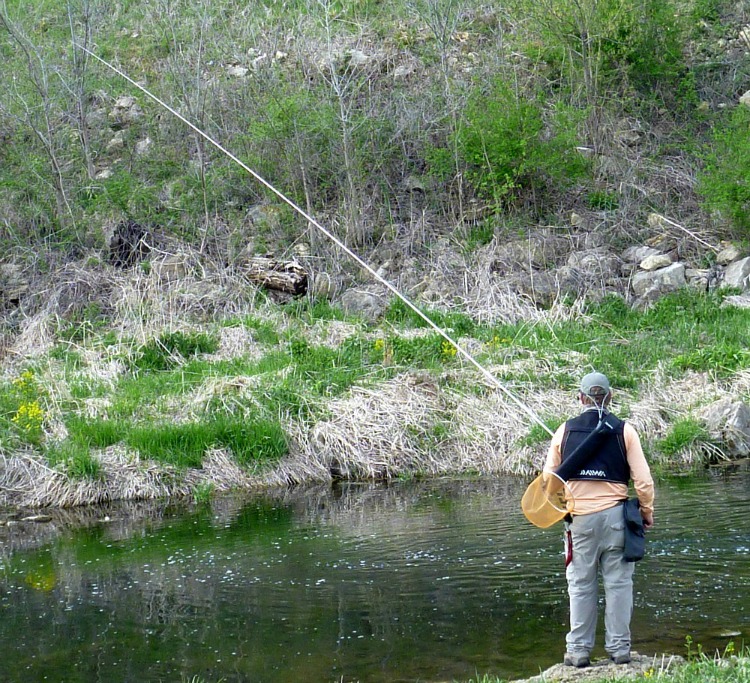
The rods are long, generally at least 17 feet, which means they are generally two-handed rods. They are very light, though, and weigh only a few ounces. The long rod allows you to fish with your line nearly vertical, so it is not affected by current differentials. The current in a stream is not uniform, and if your line crosses currents flowing at different speeds, your bait will be pulled faster (or slower!) than the current it is in. A trout has a brain the size of a pea, but it knows when something is moving too slow or too fast.
If you cast out from shore with a short spinning rod, your line will cross a number of different currents, so it is certain that your bait will be moving too slow or too fast relative to the current it is actually in.
Worse, if you only fish pools and use enough weight to anchor your bait to the bottom, you don't have a chance to catch any of the fish that are in the riffles and pocket water. Only a fraction of the fish in a stream are in the pools. I see a few bait fishermen in the streams I fish, but I almost never see them anywhere but sitting alongside a pool. I never see them catch many fish, either. There's no finesse in having your bait anchored to the bottom and waiting for a fish to find it!
Light Line
The finesse bait fishing that Japanese keiryu anglers do uses light (to extremely light) lines. There are keiryu rods designed for use with lines of less than one pound breaking strength, and nearly all are limited to no more than 5# test line. The line, whether specific keiryu fishing line or fly fishing tippet, is much thinner for a given pound test rating than spinning line. To achieve the maximum finesse, the thinnest line must be used. There's a reason fly fishermen use very light tippets. Bait fishermen should use very light tippets for the same reason! Lighter lines allow a more natural presentation, and a more natural presentation catches more fish.

With the line nearly vertical, even the
most subtle bite is signaled by the markers attached to the line. There
are a couple types of markers, but the lightest is a
thin, slightly fluffy yarn that is brightly colored and does not absorb
water. The yarn from your wife's knitting bag is NOT going to work. You'll need special yarn intended just for keiryu markers.
Three or four knots of the marker yarn are tied around the line, positioned so that the lowest marker is above the water's surface. The knots are tied so that the markers can be moved easily, but will stay where you put them. When a fish takes the bait, the markers clearly show that the line either stops or dips or moves to the side.
For finesse bait fishing, with a small bait, light wire hook, tiny split shot and gossamer tippet, you will be able to detect the most subtle take - and some are indeed subtle. When fishing in current, hold the bait back just a bit, so your line is drifting a bit slower than the surface current. The current on the bottom is slower than on the surface, and you want your bait to be drifting at the speed of the current around it.
Occasionally, the take will not be at all subtle, and you markers will dip violently or shoot to the side. Often, though, the line will just stop. That is almost immediately obvious because the angle of the markers will change, going from the lowest marker being furthest downstream, to vertical, to the lowest marker being upstream. That could happen when the bait or split shot gets caught on a rock or when a fish takes the bait but then doesn't move.
When that happens, just tighten the line by moving the rod back upstream (quickly but not forcefully). If the bait is caught on a rock, that generally frees it. If it is a fish, the light wire hook penetrates so easily that no "hook set" is necessary, and the fish's first reaction to pull away provides all the hook set that is necessary. In essence, when the markers just stop, you don't know at first if it is a rock or a fish. Tighten the line. If it is a fish it will wiggle!
The setup is so sensitive that you can react and set the hook before a fish has time to swallow the bait. Deep hooking is thus not at all common, so catch and release bait fishing is quite possible.
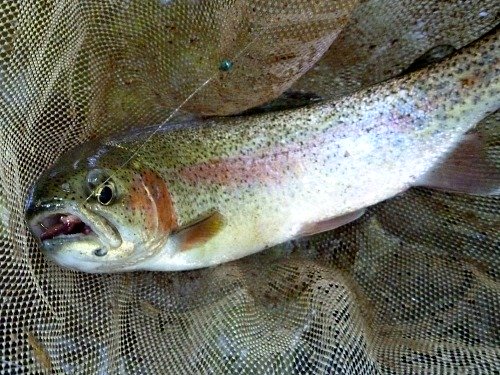
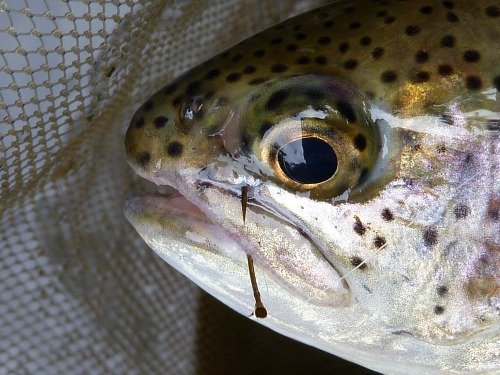
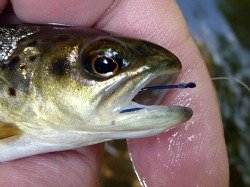
The great drifts you can get with a very long keiryu rod, together with the extremely sensitive bite detection means that keiryu fishing really is the ultimate in finesse bait fishing for trout in streams.
If you enjoy bait fishing for trout in streams, and you currently do it with a spinning rod, you really do owe it to yourself to try it with a long keiryu rod. You will get better drifts. You will catch more fish. You will have fewer deep hooked fish. This system really does make bait fishing finesse fishing.
Header photo: Tenryu Rayz RZ4102B-UL, Shimano Calcutta Conquest BFS-HG ('17)
Warning:
The hooks are sharp.
The coffee's hot.
The fish are slippery when wet.
Whatever you do, do it with finesse!